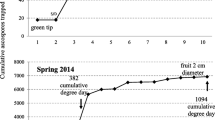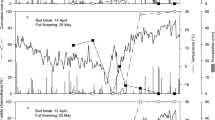Abstract
We investigated the diurnal pattern of ascospore discharge of the Japanese pear scab fungus (Venturia nashicola Tanaka & Yamamoto) in an orchard. Ascospores of V. nashicola were mainly discharged during the day. Most ascospores were discharged from 7:00 to 19:00: 99.6% in 2001, 99.3% in 2002, and 93.8% in 2005. Because the ascospores were discharged only when the fallen diseased leaves were wet from precipitation, the wetness of these leaves is probably imperative for spore discharge. Ascospore discharge began immediately after precipitation in the daytime. When it rained at night, however, ascospore discharge did not begin until the following morning and never began immediately after precipitation. We also investigated other meteorological factors. When fallen diseased leaves were wet, the percentage of ascospore discharge was positively correlated with the amount of solar radiation and atmospheric temperature and negatively correlated with relative humidity. Ascospore discharge was interrupted by a decrease in solar radiation and atmospheric temperature and by increased relative humidity at night. This report is the first that V. nashicola discharges ascospores primarily during the day.





Similar content being viewed by others
References
Aylor DE, Anagnostakis SL (1991) Active discharge distance of ascospores of Venturia inaequalis. Phytopathology 81:548–551
Brook PJ (1969) Stimulation of ascospore release in Venturia inaequalis by far red light. Nature 222:390–392
Brook PJ (1975) Effect of light on ascospore discharge by five fungi with bitunicate asci. New Phytol 74:85–92
Gadoury DM, Seem RC, Stensvand A (1994) Ascospore discharge in Venturia inaequalis. In: Butt DJ (ed) Integrated control of pome-fruit diseases. Norw J Agric Sci Suppl 17, pp 205–219
Gadoury DM, Stensvand A, Seem RC (1998) Influence of light, relative humidity, and maturity of populations on discharge of ascospores of Venturia inaequalis. Phytopathology 88:902–909
Koike H (1994) Experimental use of 7-day recording spore trap and patterns of ascospore discharge by Venturia inaequalis. Ann Phytopathol Soc Jpn 60:355–356 (in Japanese)
Latorre BA, Yanez P, Rauld E (1985) Factors affecting release of ascospores by the pear scab fungus (Venturia pirina). Plant Dis 69:213–216
MacHardy WE (1996) Apple scab. APS, St Paul, pp 280–288
MacHardy WE, Gadoury DM (1986) Patterns of ascospore discharge by Venturia inaequalis. Phytopathology 76:985–990
Ootani T, Tanaka K, Sugahara K, Laurenson M, Watanabe T, Umemoto S, Takeuchi T (2002) Validation of a forecasting model for Japanese pear scab infection associated with local weather data. Ann Phytopathol Soc Jpn 68:200 (in Japanese)
Umemoto S (1990) Infection sources in Japanese pear scab (Venturia nashicola) and their significance in the primary infection. Ann Phytopathol Soc Jpn 56:658–664 (abstract in Japanese)
Umemoto S (1991) Relationship between leaf wetness period, temperature and infection of Venturia nashicola to Japanese pear leaves. Ann Phytopathol Soc Jpn 57:21–218
Umemoto S (1993) Studies on the ecology and control of Japanese pear scab. Spec Bull Chiba Prefectural Agric Exper Stn 22:27–34 (in Japanese)
Acknowledgments
We are grateful to Drs. Seisaku Umemoto (Chiba Plant Protection Office) and Souichi Kobayashi (Nagano Vegetable and Ornamental Crops Experiment Station), who provided us with the motivation and opportunity to carry out this study. We extend special thanks to Dr. Yukari Kuga (Faculty of Agriculture, Shinshu University) for helpful suggestions and invaluable discussions.
Author information
Authors and Affiliations
Corresponding author
Rights and permissions
About this article
Cite this article
Eguchi, N., Yamagishi, N. Ascospores of the Japanese pear scab fungus (Venturia nashicola Tanaka & Yamamoto) are discharged during the day. J Gen Plant Pathol 74, 41–45 (2008). https://doi.org/10.1007/s10327-007-0064-2
Received:
Accepted:
Published:
Issue Date:
DOI: https://doi.org/10.1007/s10327-007-0064-2




